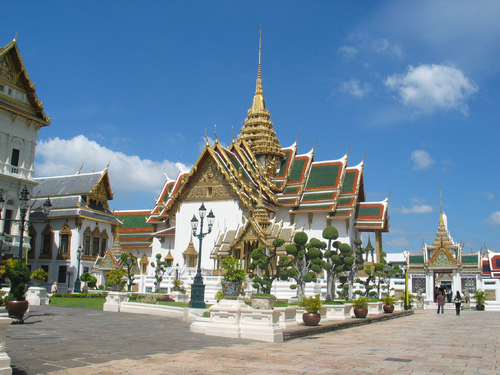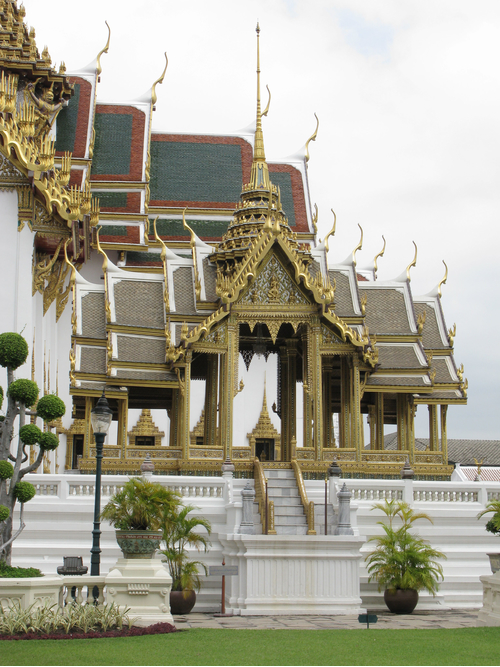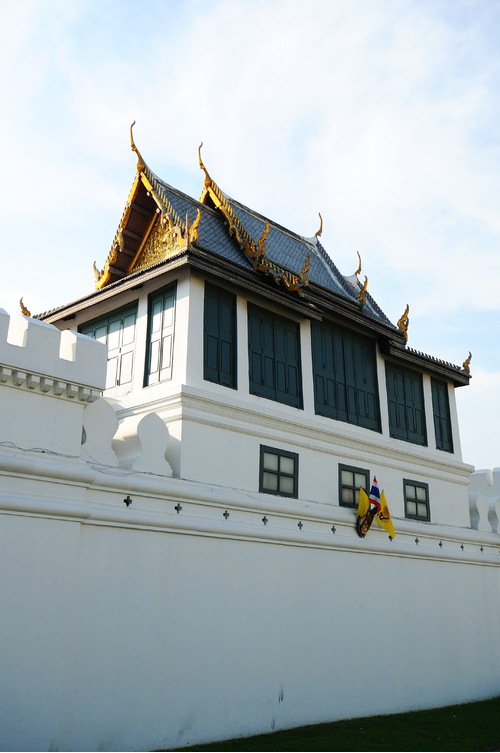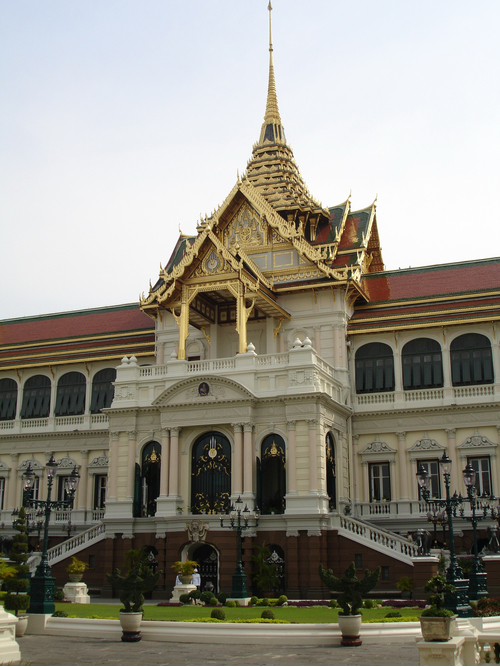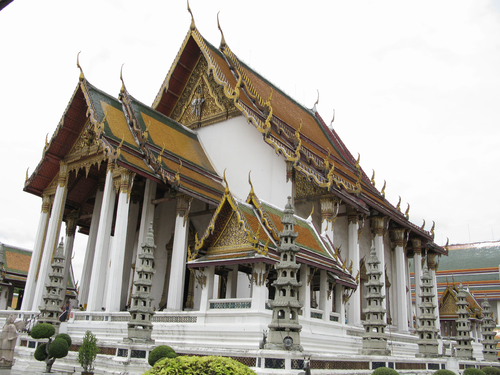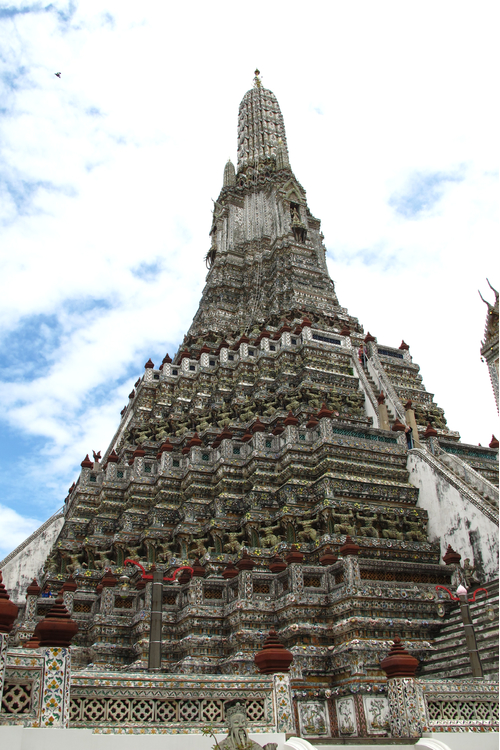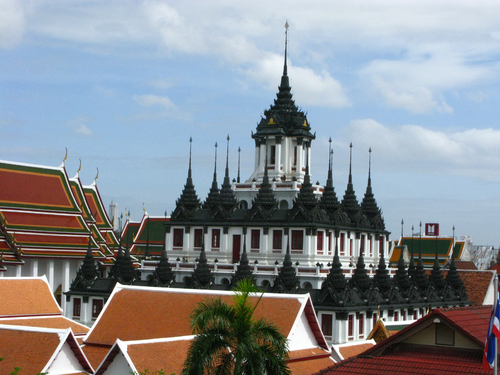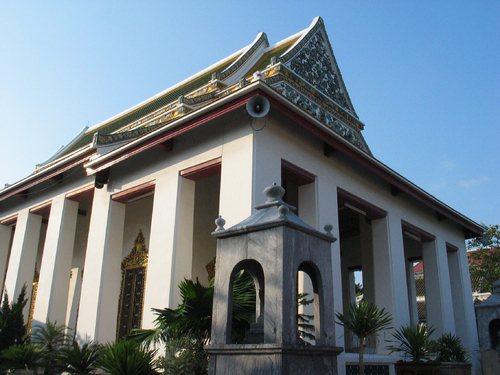ค้นหางานศิลปกรรม
ฐานข้อมูลศิลปกรรมในเอเชียตะวันออกเฉียงใต้
สถาปัตยกรรมพระที่นั่งดุสิตมหาปราสาท
พระที่นั่งดุสิตมหาปราสาทมีแผนผังเป็นอาคารทรงจัตุรมุขโถง ตัวอาคารก่ออิฐถือปูน ด้านนอกฉาบผนังเรียบทาสีขาว หลังคาเป็นเครื่องไม้ทรงจตุรมุขซ้อนชั้น ประดับเครื่องลำยองโดยปลายกรอบหน้าบันมีองค์ประกอบที่มีลักษณะเด่น เรียกว่านาคเบือน หลังคาพระที่นั่งมุงกระเบื้องเคลือบสีเขียวขอบสีส้ม ส่วนบนของเครื่องหลังคาประดับเรือนยอดแบบพระมหาปราสาท มุขด้านเหนือมีมุขเด็จยื่นมาทางด้านหน้าซึ่งประดิษฐานบุษบก มุขด้านใต้ภายในพระที่นั่งเจาะผนังเป็นพระที่นั่งบุษบกซึ่งสร้างเพิ่มเติมในสมัยรัชกาลที่ 4 มุขทิศตะวันตกสำหรับประดิษฐานพระโกศพระบรมศพของพระมหากษัตริย์และพระบรมวงศ์ชั้นสูง มีทางเชื่อมไปยังศาลาเปลื้องเครื่องที่ตั้งอยู่ทางทิศตะวันตกมุขทิศตะวันออกมีทางเชื่อมไปยังพระที่นั่งอาภรณ์พิโมกข์ปราสาท ซุ้มพระทวารและซุ้มบัญชรเป็นเรือนยอด ภายในพระที่นั่งตกแต่งด้วยจิตรกรรมฝาผนังลายเทพนมพุ่มข้าวบิณฑ์ ประดับดาวเพดานไม้แกะสลักปิดทองประดับกระจก
สถาปัตยกรรมพระที่นั่งอาภรณ์พิโมกข์ปราสาท
พระที่นั่งอาภรณ์พิโมกข์ปราสาทมีแผนผังเป็นทรงจัตุรมุข โดยด้านทิศเหนือและทิศใต้เป็นมุขยาว ส่วนทิศตะวันออกและทิศตะวันตกเป็นมุขสั้น หลังคาซ้อนชั้นทำด้วยเครื่องไม้ประดับเครื่องลำยอง ปิดทองประดับกระจกมุงกระเบื้องดาดดีบุก ส่วนกลางชั้นหลังคาประดับเรือนยอดแบบพระมหาปราสาท หน้าบันพระที่นั่งเป็นรูปเทวดาประทับยืนบนแท่น พระหัตถ์ซ้ายถือพระขรรค์ สองข้างมีเทพนม เสารับโครงสร้างพระที่นั่งปิดทองประดับกระจก มีบัวหัวเสาเป็นบัวแวง พระที่นั่งอาภรณ์พิโมกข์เป็นพระที่นั่งโถง ไม่มีผนัง ด้านหน้ามีบันไดทอดมายังเกยสำหรับเทียบพระราชยาน
สถาปัตยกรรมพระที่นั่งไชยชุมพล
พระที่นั่งไชยชุมพลเป็นพระที่นั่งชั้นเดียวบนกำแพงพระบรมมหาราชวัง องค์พระที่นั่งก่ออิฐถือปูนในผังรูปสี่เหลี่ยมผืนผ้า ยกพื้นสูงเสมอกำแพง มีพระบัญชรที่เปิดถึงพื้นทั้ง 4 ด้าน พระทวารและพระบัญชรเป็นบานเกล็ดไม้ทาสี หลังคาเป็นทรงไทยซ้อน 2 ชั้น ซึ่งอาจเรียกการซ้อนชั้นเช่นนี้ว่าออกมุขลดทั้งทางด้านหน้าและด้านหลัง หลังคามุงด้วยกระเบื้องดีบุก เครื่องลำยองปิดทองประดับกระจก ประกอบด้วยช่อฟ้า ใบระกา หางหงส์ นาคสะดุ้ง ที่หน้าบันเป็นรูปกองทัพทั้ง 4 เหล่า ได้แก่ ทัพช้าง ทัพม้า พลรถ และพลเดินเท้า นักวิชาการบางท่านสันนิษฐานว่าเป็นภาพกระบวนแห่ในพระราชพิธีตรียัมปวาย หรือเป็นกระบวนสวนสนามของเหล่าทัพต่างๆ ซึ่งน่าจะออกแบบเพื่อให้สอดคล้องกับการที่ใช้พระที่นั่งไชยชุมพลเป็นสถานที่ประทับทอดพระเนตรการฝึกทหารและกระบวนแห่ในการพระราชพิธีนั้น นอกจากนี้ที่ตอนบนสุดของหน้าบันยังมีภาพเทวดาทรงปลาเป็นพาหนะ พระหัตถ์ซ้ายถือพระขรรค์และพระหัตถ์ขวาถือรวงข้าวปรากฏอยู่ด้วย รูปเทวดานี้สามารถเทียบเคียงได้กับรูปพระมหาชัยหรือพระไพรสพซึ่งเป็นเทพแห่งความอุดมสมบูรณ์ การทำรูปเทวดาที่หน้าบันนี้จึงน่าจะมีความหมายว่ามีเทวดารักษาคุ้มครองและอำนวยพรแก่เหล่ากองทัพต่างๆ หรือกระบวนแห่ในพระราชพิธีเพื่อความอุดมสมบูรณ์ของบ้านเมืองด้วย
สถาปัตยกรรมพระที่นั่งจักรีมหาปราสาท
พระที่นั่งจักรีมหาปราสาทเป็นสถาปัตยกรรมแบบยุโรป สูง 3 ชั้น แบ่งเป็น 3 มุข โดยมีบริเวณที่เรียกว่า มุขกระสันเชื่อมต่อถึงกันจากด้านตะวันออกถึงตะวันตก มุขทั้ง 3 รองรับเครื่องหลังคาทรงปราสาทยอดส่วนหลังคาและยอดพระที่นั่งเป็นทรงปราสาทยอดแบบไทยประเพณี แต่ด้วยการประกอบเข้ากับสถาปัตยกรรมแบบตะวันตก จึงทำให้มีสัดส่วนที่ต่างไปจากพระมหาปราสาทองค์อื่น เช่น ความเอียงลาดของหลังคาที่น้อยลง เครื่องลำยองที่มีขนาดอ้วนและสั้นกว่าปกติ เป็นต้นมุขกลางมีมุขเด็จสำหรับเสด็จออก ที่พระเฉลียงของมุขเด็จประดิษฐานพระบรมรูปพระบาทสมเด็จพระจุลจอมเกล้าเจ้าอยู่หัวแบบเหมือนจริงทำด้วยโมเสกตัวอาคารตกแต่งด้วยศิลปะตะวันตกยุคเรเนสซองส์ ประดับช่องหน้าต่างวงโค้งที่ชั้นบน ส่วนชั้นที่สองเป็นช่องหน้าต่างในกรอบสี่เหลี่ยม คั่นจังหวะด้วยเสาโครินเธียนติดผนัง รายละเอียดทางสถาปัตยกรรมมีความเปลี่ยนแปลงไปจากพระมหาปราสาทแบบไทยประเพณี กล่าวคือ มีการประดับสัญลักษณ์ต่างๆที่มีความเกี่ยวข้องกับสถาบันพระมหากษัตริย์ โดยไม่ใช้รูปนารายณ์ทรงครุฑอีกต่อไป แต่ได้ใช้รูปสัญลักษณ์อื่นๆ เช่น พระจุลมงกุฎหรือพระเกี้ยวประดิษฐานบนพานแว่นฟ้า รองรับด้วยช้างสามเศียรซึ่งหมายถึงพระบาทสมเด็จพระจุลจอมเกล้าเจ้าอยู่หัว รูปจักรและตรีล้อมด้วยสายสังวาลนพรัตน์ซึ่งเป็นสัญลักษณ์ที่สื่อความหมายถึงพระราชวงศ์จักรี รวมทั้งยังประดับตราประจำแผ่นดินในสมัยรัชกาลที่ 5
สถาปัตยกรรมพระวิหารหลวง วัดสุทัศนเทพวราราม
พระวิหารหลวงมีแผนผังรูปสี่เหลี่ยม ตั้งอยู่บนฐานไพทีสูง ด้านหน้าหันทางทิศเหนือ ตัวอาคารก่ออิฐถือปูน หลังคาเครื่องไม้มุงกระเบื้องสีส้มสลับเขียวซ้อนชั้น กรอบหน้าบันประดับเครื่องลำยอง มีเสาพาไลย่อมุมรองรับเครื่องหลังคาโดยรอบพระวิหาร เสาพาไลประดับบัวหัวเสาปิดทองประดับกระจกและมีคันทวย หน้าบันเครื่องไม้ปิดทองประดับกระจกรูปพระอินทร์ทรงช้างเอราวัณ ด้านหน้าพระวิหารหลวงทางทิศเหนือมีมุขลด เครื่องหลังคาซ้อนชั้น ที่หน้าบันประดับรูปพระนารายณ์ทรงครุฑ
สถาปัตยกรรมพระปรางค์ วัดอรุณราชวราราม
รูปแบบพระปรางค์วัดอรุณมีลักษณะที่พัฒนามาจากพระปรางค์ในศิลปะอยุธยา ส่วนฐานมีลักษณะผายกว้าง ประกอบด้วยชั้นซ้อนลดหลั่น แต่ละชั้นประดับด้วยประติมากรรมพลแบก ฐานลดหลั่นนี้ได้เอนสอบขึ้นไปรองรับเรือนธาตุซึ่งมีจระนำทั้งสี่ด้าน ประดิษฐานรูปพระอินทร์ทรงช้างเอราวัณแทนการประดิษฐานพระพุทธรูปที่เป็นแบบแผนดั้งเดิม ซึ่งการประดับรูปพระอินทร์ที่เรือนธาตุนี้นักวิชาการบางท่านเสนอว่าเป็นสัญลักษณ์ที่สะท้อนให้เห็นว่าพระปรางค์มีความเกี่ยวข้องกับเจดีย์จุฬามณีหรืออาจสะท้อนให้เห็นว่าองค์พระปรางค์หมายถึงเขาพระสุเมรุอันเป็นศูนย์กลางจักรวาลส่วนยอดของพระปรางค์ประกอบด้วยกลีบขนุนซ้อนชั้น ที่ส่วนบนของจระนำทั้งสี่ด้านประดับด้วยยอดปรางค์ขนาดเล็ก เมื่อนับรวมยอดทั้งหมดจึงเป็น 5 ยอดซึ่งการประดับยอดบริวารเช่นนี้เป็นรูปแบบที่เคยมีมาก่อนในศิลปะอยุธยา
สถาปัตยกรรมโลหะปราสาท
โลหะปราสาทเป็นอาคารทรงปราสาทก่ออิฐถือปูนสูง 3 ชั้นในผังสี่เหลี่ยมจัตุรัส ประดับส่วนยอดด้วยโลหะ มีจำนวนทั้งสิ้น 37 ยอดภายในโลหะปราสาทเป็นช่องกลวงจากฐานตลอดยอด เดิมมีแกนกลางหลักเป็นซุงต้นใหญ่สูงถึงยอดปราสาท โดยเจาะลำต้นตอกเป็นบันไดเวียนขึ้นไปสู่ชั้นบน ต่อมาเมื่อได้รับการปฏิสังขรณ์จึงเป็นอาคารคอนกรีตเสริมเหล็ก
สถาปัตยกรรมพระอุโบสถ วัดราชโอรสาราม
พระอุโบสถเป็นอาคารขนาดใหญ่ก่ออิฐถือปูน มีเสาพาไลสี่เหลี่ยมขนาดใหญ่ไม่ประดับบัวหัวเสารองรับน้ำหนักซึ่งทำให้อาคารดูมั่นคงแข็งแรง เครื่องหลังคาไม่ใช้เครื่องไม้ แต่เป็นงานก่ออิฐถือปูน หน้าบันไม่ประดับช่อฟ้า ใบระกา หางหงส์ แต่ประดับลวดลายอย่างจีน โดยเป็นลายสัญลักษณ์แห่งความเป็นมงคลและลายทิวทัศน์ กรอบหน้าบันประดับด้วยกระเบื้องเคลือบเป็นเครื่องถ้วยจีน หน้าบันแบ่งเป็น 2 ตับ ตับบนประดับรูปแจกันและช่อดอกไม้ขนาดใหญ่ที่กึ่งกลาง ขนาบข้างด้วยมังกรคู่ ถัดขึ้นไปเป็นหงส์คู่ และลายมงคลอื่นๆ ตับล่างเป็นภาพทิวทัศน์ มีบ้าน ภูเขา เขามอ ต้นไม้และสัตว์ต่างๆ
